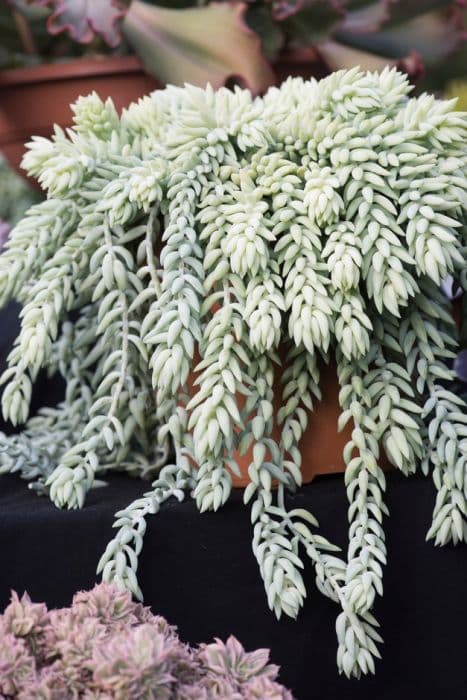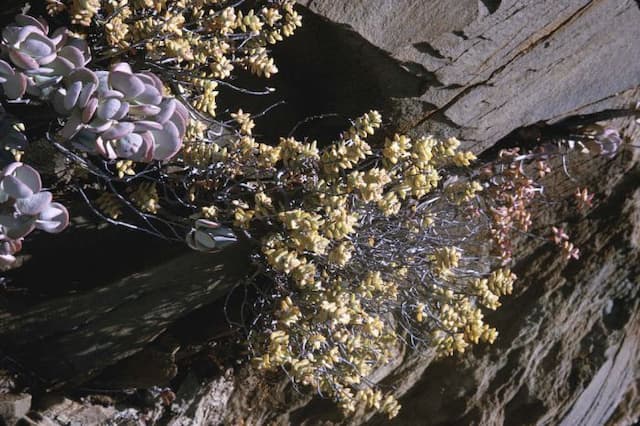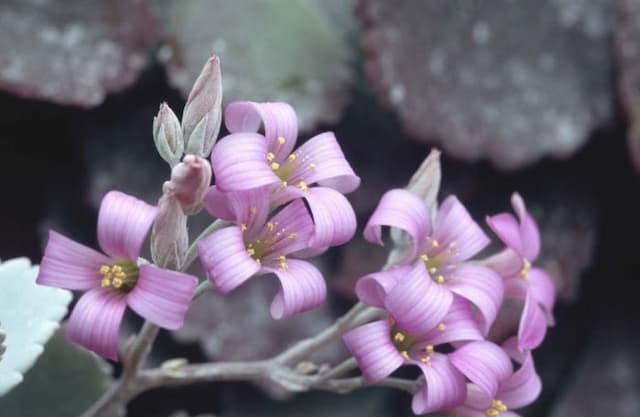Beach Bells Kalanchoe manginii

ABOUT
Kalanchoe manginii, also known as beach bells, is a charming succulent plant that boasts a distinctive appearance. It has thick, glossy, fleshy green leaves that are oval-shaped with a slight scalloping on the edges. These leaves often have a reddish tint along the margins, adding a hint of color to the green foliage. The plant is well-known for its attractive flowers, which resemble little bells, hence the common name. These flowers dangle from arching stems and come in a vibrant shade of pink. Each flower has a flared, bell-like shape with petals that curve back, giving it an elegant look. The stamens are visible within the bell structure, usually in a contrasting yellow or orange hue, which stands out against the pink petals. Beach bells can often be seen with multiple flowers blooming simultaneously, creating a delightful and eye-catching display. The overall appearance of the plant is lush and plump, making it a popular choice for indoor plant enthusiasts who appreciate its easy-care nature and ornamental qualities.
About this plant
 Names
NamesFamily
Crassulaceae.
Synonyms
Chandelier Plant, Beach Bells, Mangin's Kalanchoe, Miracle Leaf.
Common names
Bryophyllum manginii, Kalanchoe fedtschenkoi var. manginii.
 Toxicity
ToxicityTo humans
The plant known as Chandelier Plant is considered mildly toxic to humans if ingested. The toxic elements of this succulent are cardiac glycosides, which can cause symptoms such as vomiting, diarrhea, and in severe cases, abnormal heart rhythm. While fatalities are rare, it is advised to keep this plant out of reach of children who might accidentally consume it.
To pets
Chandelier Plant is toxic to pets, especially cats and dogs. Similar to its effect on humans, the cardiac glycosides can lead to symptoms including vomiting, diarrhea, drooling, and changes in heart rate or rhythm. In severe cases, it can result in life-threatening situations such as cardiac failure. If a pet consumes any part of the plant, it is important to seek veterinary care immediately.
 Characteristics
CharacteristicsLife cycle
Perennials
Foliage type
Evergreen
Color of leaves
Green
Flower color
Pink
Height
1 foot (30 cm)
Spread
1 foot (30 cm)
Plant type
Succulent
Hardiness zones
10
Native area
Madagascar
Benefits
 General Benefits
General Benefits- Low Maintenance: Kalanchoe manginii, commonly known as Beach Bells, requires minimal care, which is ideal for busy gardeners or those new to plant care.
- Drought Tolerant: Being a succulent, it can survive with very little water, making it perfect for arid climates and water-conservation gardens.
- Attractive Flowers: Beach Bells produce bell-shaped pink flowers that can add aesthetic value to gardens and indoor spaces.
- Long Blooming Period: The plant has a long flowering season, providing color and interest for an extended period.
- Easy to Propagate: Kalanchoe manginii can be easily propagated from cuttings, allowing gardeners to create new plants for free.
- Compact Size: Its small and compact form is suitable for container gardening or small spaces.
- Interesting Foliage: The fleshy, green leaves offer textural interest even when the plant is not in bloom.
 Medical Properties
Medical PropertiesThis plant is not used for medical purposes.
 Air-purifying Qualities
Air-purifying QualitiesThis plant is not specifically known for air purifying qualities.
 Other Uses
Other Uses- Kalanchoe manginii, commonly known as the Chandelier Plant, can serve as a conversation starter due to its unique and appealing pendant bell-shaped flowers when grown as an ornamental houseplant.
- As a photography subject, the delicate blooms and fleshy leaves of Chandelier Plant offer a unique opportunity for photographers to capture its beauty in various light settings.
- In a terrarium, Chandelier Plant can be a striking addition due to its low growing habit and cascading flowers, providing a miniature garden vibe.
- For educating children about botany, Chandelier Plant is a good candidate because it exhibits interesting traits such as succulent leaves and vibrant blooms, which can illustrate plant adaptation and reproduction.
- As a natural art material, the leaves of Chandelier Plant can be used in crafting, such as creating leaf-imprinted designs or patterns on clay or cement.
- When considering feng shui, some people might place Chandelier Plants in their homes to encourage a flow of positive energy, believing that the plant's lush appearance can foster abundance and prosperity.
- In container gardens, Chandelier Plant is ideal for adding vertical interest with its cascading growth habit, pairing well with low ground-cover plants.
- During thematic events or weddings, Chandelier Plant can be incorporated into decor for ceremonies requiring a hint of greenery, especially when aiming for a rustic or garden theme.
- For relaxation spaces like a reading nook or sunroom, having a Chandelier Plant can contribute to a tranquil environment with its soothing green hues and charming flowers.
- In culinary presentations, while not edible, the striking appearance of Chandelier Plant can be used as temporary ornamental garnish to enhance the visual presentation of dishes at upscale events (making sure it doesn't come into contact with food).
Interesting Facts
 Feng Shui
Feng ShuiThe Beach Bells is not used in Feng Shui practice.
 Zodiac Sign Compitability
Zodiac Sign CompitabilityThe Beach Bells is not used in astrology practice.
 Plant Symbolism
Plant Symbolism- Persistence: Kalanchoe manginii, also known as the ‘Beach Bells’, is known for its ability to survive in harsh conditions, symbolizing persistence and the strength to endure tough challenges.
- Longevity: With its long-lasting blooms, Beach Bells represent longevity and the wish for a long, healthy life.
- Prosperity and Wealth: In some cultures, the vibrant, succulent leaves are seen as symbols of growth and renewal, often linked to prosperity and accumulation of wealth.
- Healing: As a medicinal plant, Beach Bells can also represent healing and the restoration of health.
 Water
WaterChandelier plant, commonly known as Kalanchoe manginii, should be watered deeply but infrequently to mimic its natural arid environment. Allow the top inch of soil to dry out completely between waterings. For a small pot, use about 8 ounces of water every 2 to 3 weeks, adjusting for humidity and temperature; less water is needed in winter. Overwatering can cause root rot, so ensure proper drainage.
 Light
LightChandelier plant thrives in bright indirect light but can tolerate some direct sunlight, especially in the morning. It's best placed in an east-facing or south-facing window where it will receive ample light without the harsh midday sun. Avoid placing it in dimly lit areas, as insufficient light may lead to leggy growth.
 Temperature
TemperatureChandelier plant prefers a temperature range between 60°F and 85°F and can tolerate a minimum of 40°F for short periods. The ideal condition is moderate room temperature without drastic fluctuations. Protect the plant from cold drafts and avoid temperatures falling below 50°F to prevent stress.
 Pruning
PruningPrune Chandelier plant to maintain its shape and encourage bushier growth. Deadhead spent flowers and trim back overgrown branches in the spring or after blooming periods. Pruning once or twice a year typically suffices and encourages the plant to produce more blooms.
 Cleaning
CleaningAs needed
 Soil
SoilBeach bells thrive in well-draining soil with a mix of 60% peat moss, 30% perlite, and 10% sand to facilitate drainage. A slightly acidic to neutral pH of 6.0 to 7.5 is ideal for their growth.
 Repotting
RepottingBeach bells should be repotted every two to three years or when they outgrow their container to refresh the soil and encourage further growth.
 Humidity & Misting
Humidity & MistingBeach bells prefer moderate humidity levels around 40-60%, which is typical for indoor environments, without the need for additional humidity control.
 Suitable locations
Suitable locationsIndoor
Grow Beach bells in bright, indirect light and avoid over-watering.
Outdoor
Place Beach bells in dappled sunlight and protect from harsh conditions.
Hardiness zone
10-12 USDA
 Life cycle
Life cycleKalanchoe manginii, commonly known as Beach Bells, begins its life cycle as a seed that germinates in well-draining soil with adequate warmth and light. Upon sprouting, its roots anchor into the soil while the shoot pushes upward, forming juvenile leaves. As the plant matures, it develops a robust succulent stem with fleshy, oval-shaped leaves that are capable of storing water to tolerate dry conditions. Beach Bells undergo vegetative growth, expanding in size and possibly producing offsets or plantlets on leaf margins, a form of asexual reproduction. Once reaching maturity, it produces bell-shaped, pendant flowers, often in the late winter to early spring, which are pollinated by insects, resulting in seed production to complete the reproductive cycle. After flowering, the parent plant may experience a period of dormancy or reduced growth before the cycle begins anew.
 Propogation
PropogationPropogation time
Spring-Early Summer
The most popular method of propagation for the Kalanchoe manginii, commonly known as the Chandelier Plant, is through leaf cuttings. To propagate, a healthy leaf is chosen and carefully snipped off using a pair of clean, sharp scissors. The leaf should then be left in a warm, dry place for a couple of days to allow the cut end to callous over to prevent rot. Once the end has calloused, the leaf is placed on top of a well-draining soil mixture, slightly pushing the cut end into the soil to ensure it stands upright. The leaf cutting should be kept in a bright, indirect light location and watered sparingly to keep the soil just moist. In a few weeks, tiny plants begin to emerge at the base of the leaf, signifying successful propagation. These can be left to grow larger before individually repotting, if desired.









